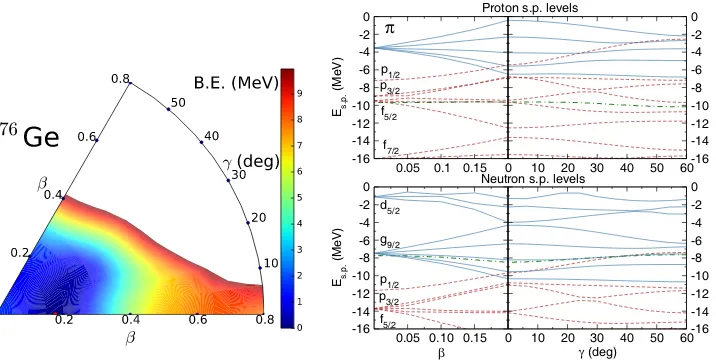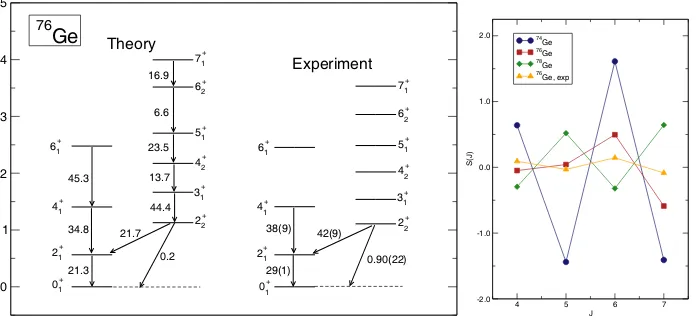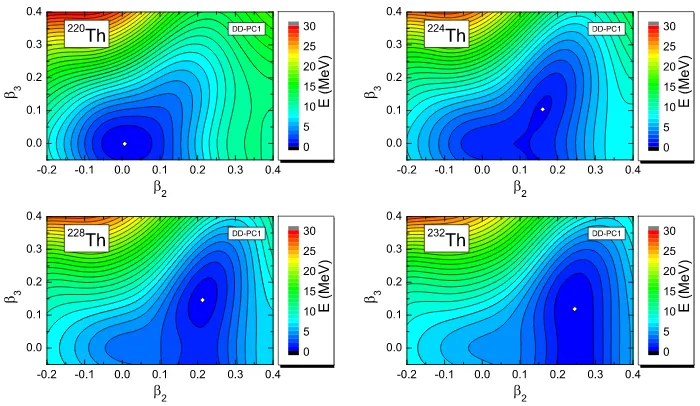Nuclear shape phase transitions
D. Vretenar
Physics Department, Faculty of Science, University of Zagreb, Zagreb, Croatia
Abstract
The evolution of shapes and shape (phase) transitions, including re-gions of short-lived exotic nuclei that are becoming accessible in experi-ments at radioactive-beam facilities, are governed by the shell structure of single-nucleon orbitals. In most cases the transition between differ-ent shapes is gradual but in a number of examples, with the addition or subtraction of only few nucleons, signatures of abrupt changes in observables are noticed. A quantitative analysis necessitates accurate modelling of the underlying nucleonic dynamics. Important advances have been reported in theoretical studies of complex shapes, especially in the “beyond mean-field” framework based on density functionals.
1
Introduction and theory framework
shell gaps, modifications of magic numbers, occurrence of islands of inver-sion, deformed equilibrium shapes and coexistence of shapes with different deformations, and shape (phase) transitions.
As the number of nucleons changes from nucleus to nucleus, in gen-eral one observes a gradual evolution of different shapes – spherical, axially quadrupole deformed, shapes that are soft with respect to triaxial deforma-tions, octupole shapes [1,2]. In a number of cases the addition or subtraction of only a few nucleons leads to rapid changes in equilibrium shapes and shape phase transitions may occur [4]. Phase transitions in the equilibrium shapes of nuclei correspond to first- and second-order quantum phase transitions (QPTs) between competing ground-state phases induced by variation of a non-thermal control parameter at zero temperature. Particularly important are studies of observables that can be related to order parameters and the degree to which discontinuities at a phase transitional point are smoothed out in finite nuclei. In recent years nuclear QPTs have been investigated ex-tensively, both in experimental studies and employing a variety of theoretical models. An integral microscopic description of these universal phenomena must be based on a theoretical framework that can be extended from light to heavy nuclei, and from the line ofβ-stability to the nucleon drip lines. Such a framework is the one based on nuclear density functional theory (DFT).
Over the last two decades a number of successful relativistic mean-field (RMF) models have been constructed based on the framework of quantum hadrodynamics, in which a nucleus is described as a system of Dirac nucleons coupled to exchange mesons through an effective Lagrangian [8]. However, at energies characteristic for nuclear structure phenomena, meson exchange (σ,ω,ρ,. . .) is just a convenient representation of the effective inter-nucleon interaction. The exchange of heavy mesons is not resolved at low energies, and can be replaced by the corresponding local contact interactions between nucleons.
The basic building blocks of a relativistic nuclear energy density func-tional are the densities and currents bilinear in the Dirac spinor field ψ
of the nucleon: ψ¯OτΓψ, Oτ ∈ {1, τi}, Γ ∈ {1, γμ, γ5, γ5γμ, σμν}. Here
τi are the isospin Pauli matrices. The nuclear ground-state density and energy are determined by the self-consistent solution of relativistic linear single-nucleon Kohn-Sham equations. To derive those equations it is use-ful to construct an interaction Lagrangian with contact interaction terms in the various isospace-space channels: isoscalar-scalar ( ¯ψψ)2, isoscalar-vector ( ¯ψγμψ)( ¯ψγμψ), isovector-scalar ( ¯ψ τ ψ)·( ¯ψ τ ψ), and isovector-vector ( ¯ψ τ γμψ)·( ¯ψ τ γμψ) . A general Lagrangian can be written as a power series in the currents ¯ψOτΓψand their derivatives, with higher-order terms repre-senting in-medium many-body correlations. Alternatively, one constructs a Lagrangian that comprise second-order interaction terms only, with many-body correlations encoded in density-dependent coupling functions. This type of RMF-based models has been successfully used in analyses of a vari-ety of structure phenomena, not only in nuclei along the valley ofβ-stability, but also in exotic nuclei with extreme isospin values and close to the par-ticle drip lines. In the present study illustrative calculations are performed with the EDF DD-PC1 [9]. Starting from microscopic nucleon self-energies in nuclear matter, the density-dependent coupling parameters of the DD-PC1 point-coupling Lagrangian were fine-tuned to the experimental masses of a set of 64 deformed nuclei in the mass regions A ≈ 150−180 and
A ≈ 230−250. The functional has been further tested in a number of mean-field and beyond-mean-field calculations in different mass regions. For the examples considered here, pairing correlations are taken into account by employing an interaction that is separable in momentum space, and is com-pletely determined by two parameters adjusted to reproduce the empirical bell-shaped pairing gap in symmetric nuclear matter [10].
is characterised by the breaking of symmetries of the underlying Hamilto-nian – translational, rotational, particle number. To calculate spectroscopic properties it is necessary to extend the SCMF scheme to include collective correlations that arise from symmetry restoration and fluctuations around the mean-field minima. Many studies of the evolution of low-energy collec-tive states have been carried out by employing the Generator Coordinate Method (GCM) in configuration mixing calculations of angular-momentum and particle-number projected states based on relativistic energy density functionals [11, 12]. The application of this method to medium-heavy and heavy nuclei presents a more involved and technically difficult problem and, therefore, only few studies of collective states in heavier systems have been reported.
In an alternative approach a collective Hamiltonian can be formu-lated, with deformation-dependent parameters determined by self-consistent mean-field calculations. The dynamics of the collective Hamiltonian is gov-erned by the vibrational inertial functions and the moments of inertia, and these functions are determined by the energy density functional and the ef-fective pairing interaction [6]. For instance, in the case of quadrupole degrees of freedom:
ˆ
Hcoll= ˆTvib+ ˆTrot+Vcoll, (1)
where the vibrational kinetic energy is parameterized by the the mass pa-rametersBββ,Bβγ,Bγγ, the three moments of inertiaIkdetermine the rota-tional kinetic energy, andVcoll is the collective potential. The self-consistent mean-field solution for the single-quasiparticle energies and wave functions for the entire energy surface, as functions of the quadrupole deformationsβ
andγ, provide the microscopic input for calculation of the mass parameters, moments of inertia and the collective potential. The Hamiltonian describes quadrupole vibrations, rotations, and the coupling of these collective modes. The diagonalization gives the excitation energies and collective wave func-tions that can be used to calculate various observables. The details of the particular implementation of the relativistic EDF-based collective Hamilto-nian used in the present study can be found in Ref. [6].
2
Triaxial shapes in germanium isotopes
0.05 0.1 0.15 -16 -14 -12 -10 -8 -6 -4 -2 0 Es.p. (MeV)
0 10 20 30 40 50 60-16
-14 -12 -10 -8 -6 -4 -2 0
0.05 0.10 0.15 E -16 -14 -12 -10 -8 -6 -4 -2 0 Es.p. (MeV)
0 10 20 30 40 50 60
J (deg)
-16 -14 -12 -10 -8 -6 -4 -2 0 S
Neutron s.p. levels
p3/2 p1/2 d5/2 g9/2 p3/2 p1/2 f5/2 f7/2 f5/2
Proton s.p. levels
Figure 1: Left: Self-consistent RHB deformation energy surface of76Ge in theβ−γ plane (0≤γ≤600). Right: Proton and neutron energy levels of76Ge as functions of the deformation parameters.
angular variable γ. Two simple geometrical models describe the limiting cases of a triaxial shape: in the rigid-triaxial rotor model the collective potential has a stable minimum at a particular value of γ (γ-rigid poten-tial), whereas in theγ-unstable rotor model the potential is independent of
γ (γ-soft potential). A recent analysis [13] based on nuclear density func-tional theory, has shown that neither the limit of rigid-triaxial rotor nor the the γ-unstable rotor are actually realised in finite nuclei. The systematics of low-lying collective spectra and transition rates indicate that non-axial medium-heavy and heavy nuclei lie almost exactly in the middle between the two geometrical limits.
Empirical evidence for rigid triaxial deformation at low energy in 76Ge was recently reported in [14], where it was shown that the phase of the odd-even staggering of the γ-band is consistent with the assumption of a
0 1 2 3 4 5
01+ 21+ 41+ 61+
22+ 31+ 42+ 51+ 62+ 71+
Theory
Experiment
01+ 21+ 41+ 61+
22+ 31 +
42+ 51+ 62+ 71+
21.3 34.8 21.7 0.2 29(1) 38(9) 0.90(22) 42(9) 45.3 76 Ge 44.4 13.7 23.5 6.6 16.9
4 5 6 7
J -2.0 -1.0 0.0 1.0 2.0 S(J) 74Ge 76 Ge 78Ge 76Ge, exp
Figure 2: Left: The excitation spectrum of 76Ge calculated with the collective Hamiltonian and compared to data. B(E2) values are in Weisskopf units. Right: The staggeringS(J) in theγ-bands of 74,76,78Ge isotopes.
low single-particle level density around the Fermi surface. The right panel of Fig. 1 displays the proton and neutron single-particle energy levels in
76Ge. Solid (blue) and dashed (red) curves correspond to levels with
posi-tive and negaposi-tive parity, respecposi-tively. The dot-dashed (green) curves denote the Fermi level. The single-particle levels are plotted as functions of the deformation parameters along a path in theβ−γ plane. Starting from the spherical configuration, we follow the single-nucleon levels on a path along the prolate axis up to the approximate position of the minimum and then, for this fixed value of β, we trace the levels along the path fromγ = 00 to
γ = 600. Proton levels show a pronounced gap between the last occupied and first unoccupied levels in the triaxial region at γ ≈ 30◦, whereas for the neutron levels the gap appears to be almost independent ofγ. Because of small energy differences between different mean-field configurations, dy-namical effects related to restoration of broken symmetries and fluctuations in collective coordinates can have a decisive role in the eventual formation of a triaxial ground state [15].
Figure 2 displays the spectrum of 76Ge calculated with the collective Hamiltonian based on the functional DD-PC1. Levels that belong to the ground-state band and theγ-band are compared to the experimental spec-trum [14], and assigned either to the ground-state band or theγ-band ac-cording to the distribution of the projection K of the angular momentum
J on the z axis in the body-fixed frame. Yrast states have a predominant
states above the yrast characterized by dominantK = 2 components. The level ofK-mixing is reflected in the staggering in energy between odd- and even-spin states in the γ-band, and it can be quantified by considering the differential quantity:
S(J) = E[J
+
γ]−2E[(J−1)γ+] +E[(J −2)+γ]
E[2+1] . (2)
For a deformedγ-soft potential,S(J) has negative values for even-spin states and positive values for odd-spin states, with the magnitude slowly increasing with spin. For a triaxial potential the level clustering in the γ-band is opposite, and S(J) oscillates between positive values for even-spin states and negative values for odd-spin states. In the right panel of Fig. 2 we plot the calculated values for the staggering S(J) in the γ-bands of 74,76,78Ge, and the experimental values for 76Ge [14]. The phase of S(J) for 74Ge is consistent with a γ-rigid triaxial shape, whereas78Ge displays the opposite pattern forS(J), that is, the γ-band indicates a soft shapes. 76Ge is at the (shape) transition between the triaxial74Ge and theγ-soft heavier isotopes. For this nucleus the amplitudes of S(4) and S(5) almost vanish, whereas
S(6) and S(7) follow a pattern characteristic for triaxial shapes, but with considerably smaller amplitudes. The theoretical results are in very good agreement with available data, both for the ratioE(2+2)/E(2+1) = 2 and the pattern and amplitude of the staggering S(J). The self-consistent mean-field calculation has shown that the energy surface of 76Ge is γ-soft. The inclusion of collective correlations drives the nucleus toward triaxiality, but the correlations are not strong enough to stabilise aγ ≈30◦ triaxial shape.
3
Octupole shape-phase transitions in Thorium
Reflection-asymmetric shapes are characterized by the presence of negative-parity bands, and by pronounced electric dipole and octupole transitions. In the case of static octupole deformation the lowest π = +1 even-spin states and theπ =−1 odd-spin states form an alternating-parity band. Octupole deformations develop through a coupling of orbitals in the vicinity of the Fermi surface with quantum numbers (l, j) and an intruder unique-parity orbital with (l+ 3,j+ 3) [2]. For instance, in the case of the (N ≈134 and
Z ≈88) nuclei in the region of light actinides, the coupling of the neutron orbitalsg9/2 andj15/2, and that of the proton single-particle statesf7/2 and
i13/2, can result in octupole mean-field deformations.
Figure 3: Microscopic DD-PC1 self-consistent axially symmetric energy surfaces of the nuclei220−232Th in the (β2, β3) plane, symmetric with respect toβ3= 0 axis. The contours join points on the surface with the same energy, and the separation between neighbouring contours is 1 MeV.
octupole deformations to octupole vibrations [16–18]. In Fig. 3 we plot the axially symmetric deformation energy surfaces in the (β2,β3) plane for the isotopes 220−232Th, calculated with the functional DD-PC1. A soft spher-ical energy surface is predicted for 220,222Th. The quadrupole deformation becomes more pronounced in 224Th and, in addition, octupole deformation develops. The energy minimum is found in the β3 = 0 region, located at (β2, β3) ≈(0.15,0.1). From224Th to228Th a distinct octupole minimum is calculated whereas, starting from228Th, the minimum becomes softer in β3
direction. Soft octupole surfaces are predicted for230,232Th.
220 222 224 226 228 230 232 0
1 2 3
220 222 224 226 228 230 232 Mass number
Excitation energy (MeV)
(a) G.S. (K+=0+1) band
Mass number
(b) Negativeparity (K=01) band
90Th
10+ 8+ 6+
4+
2+
1
3
5 7 9
Figure 4: Isotopic dependence of the excitation energies of levels of the positive-parity ground-state band (Kπ = 0+1) (a), and the lowest negative-parity band (Kπ = 0−1) (b), for 220−232Th. In each panel solid lines and symbols denote the theoretical and experimental values, respectively.
number, reflecting the increase of quadrupole collectivity. 220,222Th exhibit a quadrupole vibrational structure, while ground-state rotational bands are obtained in226−232Th. Theπ=−1 bands form a parabolic structure centred at 226Th, in which the octupole deformed minimum is most pronounced. Starting from 226Th, the energies of negative-parity states systematically increase and the band becomes more compressed. A rotational-like collective band based on the octupole vibrational state 1−1 develops.
References
[1] Heyde K. and Wood J. L., Rev. Mod. Phys.,83(2011) 1467.
[2] Butler P. A. and Nazarewicz W.,Rev. Mod. Phys.,68(1996) 349.
[3] Sorlin O. and Porquet M.-G.,Prog. Part. Nucl. Phys.,61 (2008) 602.
[4] Cejnar P., Jolie J., and Casten R. F.,Rev. Mod. Phys.,82(2010) 2155.
[5] Bender M., Heenen P.-H., and Reinhard P.-G., Rev. Mod. Phys., 75 (2003) 121.
[6] Nikˇsi´c T., Vretenar D., and Ring P.,Prog. Part. Nucl. Phys.,66(2011) 519.
[7] Duguet T., in Lecture Notes in Physics, 879 (Springer, Heidelberg) 2014, pp. 293-350.
[8] Vretenar D., Afanasjev A.V., Lalazissis G.A., and Ring P.,Phys. Rep., 409(2005) 101.
[9] Nikˇsi´c T., Vretenar D., and Ring P.,Phys. Rev. C,78(2008) 034318.
[10] Tian Y., Ma Z. Y., and Ring P.,Phys. Lett. B,676 (2009) 44.
[11] Yao J. M., Meng J., Ring P., and Vretenar D.,Phys. Rev. C,81(2010) 044311.
[12] Yao J. M., Mei H., Chen H., Meng J., Ring P., and Vretenar D.,Phys. Rev. C,83(2011) 014308.
[13] Nomura K., Shimizu N., Vretenar D., Nikˇsi´c T., and Otsuka T., Phys. Rev. Lett.,108 (2012) 132501.
[14] Toh Y. et al.,Phys. Rev. C,87(2013) 041304(R).
[15] Nikˇsi´c T., Marevi´c P., and Vretenar D.,Phys. Rev. C,89(2014) 044325.
[16] Nomura K., Vretenar D., and Lu B.-N., Phys. Rev. C, 88 (2013) 021303(R).
[17] Li Z. P., Song B. Y., Yao J. M., Vretenar D., and Meng J.,Phys. Lett. B726, (2013) 866.



